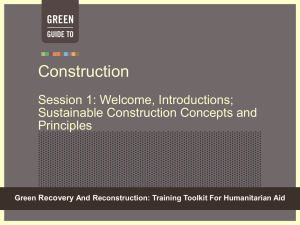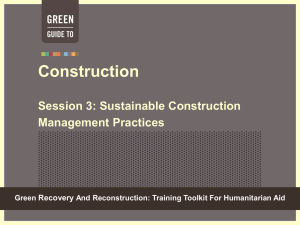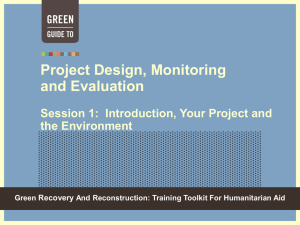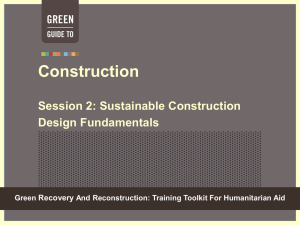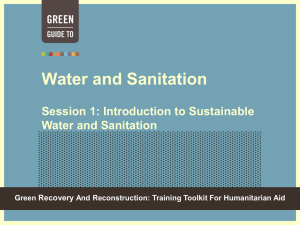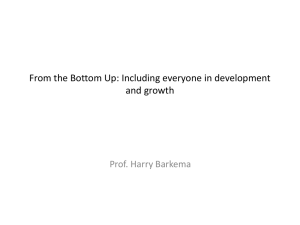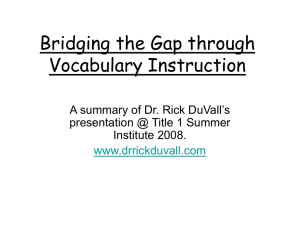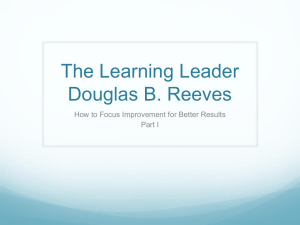Module-5-Session-2 - Green Recovery & Reconstruction
advertisement
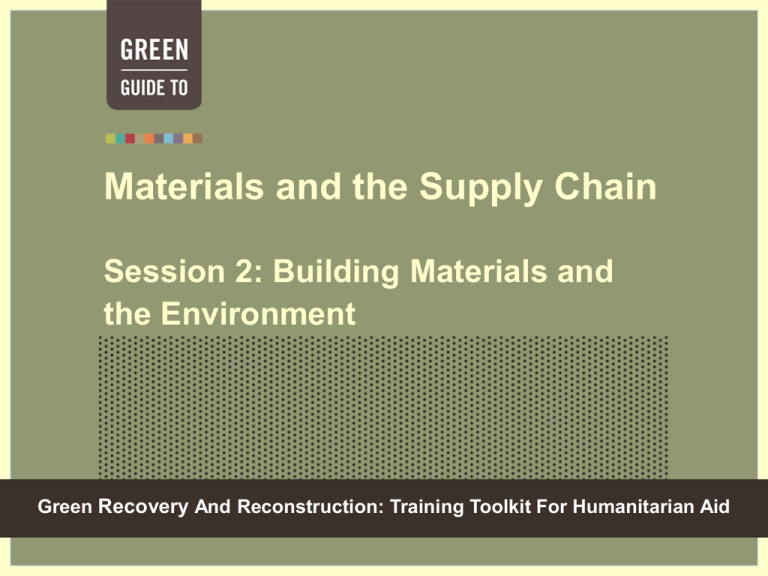
Materials and the Supply Chain Session 2: Building Materials and the Environment Green Recovery And Reconstruction: Training Toolkit For Humanitarian Aid SESSION 2 - OBJECTIVES By the end of this session, you will be able to: Demonstrate the environmental impacts of building material choices for reconstruction projects Apply the principles of the 3 Rs (reduce, reuse, recycle) to building material selection Mod 5 Ses 2 2 Application to you: What you can do in your role as program officer, project planner, or funder to achieve the aims of environmentally sustainable materials selection in reconstruction programs. Mod 5 Ses 2 3 Two tools to inform selection of building materials Life Cycle Analysis Environmental Impact Assessment Mod 5 Ses 2 4 Tool 1: Life Cycle Analysis The Cradle to Cradle Life of a Brick Extraction Processing Transport Colin Beatie Colin Beatie Building/ Maintaining Colin BeatieUN Photo/Jawad Jalali Demo/ disposal Colin Beatie Every step requires energy, and has an environmental cost Mod 5 Ses 2 5 Extraction / Photo by colin-beattie.blogspot.com Mining the clay destroys habitat and consumes energy Mod 5 Ses 2 6 Processing Six large trees are needed to fire approximately 10,000 bricks – for 1 small house. UNEP photo - A brick kiln at Abu Shouk camp in Northern Darfur Mod 5 Ses 2 7 Transport Strangecosmos.com Fuel is consumed in the transportation to the site Mod 5 Ses 2 8 Building / Maintaining UN Photo/Jawad Jalali Construction Workers in Kabul build a brick wall for a new building. Mod 5 Ses 2 9 Demolition/disposal/reuse…Back to the cradle UN HABITAT photo Tsunami destruction in Banda Aceh, Indonesia – how easy is it to reuse the bricks for reconstruction? Mod 5 Ses 2 10 This applies to all building materials, what are the energy costs associated with the “life” of this nipa palm roofing thatch? Images from www.pacificworlds.com Mod 5 Ses 2 11 Embodied Energy… ...the energy used in the work of making a product. It is an accounting methodology which aims to find the sum total of the energy necessary for an entire product lifecycle: extraction, transport, installation, etc. Expressed as mega joules of energy needed to make a kilogram of product: Mj/kg Mod 5 Ses 2 12 Photo by Colin Beatie Embodied Energy A brick is not just a brick. It also represents…. 8.4 Mj per brick of embodied energy in the UK -- as determined by the Inventory of Carbon & Energy (ICE) of the University of Bath website (https://wiki.bath.ac.uk). Mod 5 Ses 2 13 13 Quick Practice with EE Let’s build a wall……choosing the materials with the lowest EE, your choices are: Common Bricks Soil Cement Bricks Concrete Concrete Block Timber – Sawn Hardwood Timber – Sawn Softwood Particle Board or Plywood Colin Beatie Mod 5 Ses 2 14 EXAMPLE VALUES FROM THE ICE CHART OF EE VALUES MATERIAL Mod 5 Ses 2 EE – Mj/kg Common Bricks 3.00 Plywood 15.00 Sawn Softwood 7.40 Particle Board 9.50 Sawn Hardwood 7.80 Concrete Block 0.60 Concrete 0.95 Soil Cement Bricks 0.85 15 Which material has the LOWEST EE? MATERIAL Mod 5 Ses 2 EE – Mj/kg Common Bricks 3.00 Plywood 15.00 Sawn Softwood 7.40 Particle Board 9.50 Sawn Hardwood 7.80 Concrete Block 0.60 Concrete 0.95 Soil Cement Bricks 0.85 16 Which material has the HIGHEST EE? Is this all you need to know to decide which material to choose? MATERIAL Mod 5 Ses 2 EE – Mj/kg Common Bricks 3.00 Plywood 15.00 Sawn Softwood 7.40 Particle Board 9.50 Sawn Hardwood 7.80 Concrete Block 0.60 Concrete 0.95 Soil Cement Bricks 0.85 17 Analysis… Which are the materials with the lowest embodied energy from the ICE chart? What does this mean in practical terms? What else do you need to know to use this approach successfully? Mod 5 Ses 2 MATERIAL EE – Mj/kg Common Bricks 3.00 Plywood 15.00 Sawn Softwood 7.40 Particle Board 9.50 Sawn Hardwood 7.80 Concrete Block 0.60 Concrete 0.95 Soil Cement Bricks 0.85 18 Why is the concept of embodied energy relevant to us? Mod 5 Ses 2 19 Tool 2: Environmental Impact Assessment A brick is not just a brick – environmental effects will be different for different groups or locations or ecosystems Earth, air and water Wildlife and plants Mod 5 Ses 2 Local population Homeowners Artisans and builders 20 Assess who is affected http://www.speak.org.uk/files/images/Deforestation_2e.img_assist_custom.jpg Wood harvesting leading to deforestation Mod 5 Ses 2 21 Assess what is affected Collection of traditional building materials at an unsustainable rate affects the ability for some species to regenerate and destroys habitat for other species. Mod 5 Ses 2 22 Assess where are the effects? UNEP photo – S. Rocha Mod 5 Ses 2 23 Environmental Impact Assessment Tools See Module 3 Environmental Impact Assessment Tools and Techniques Environmental Stewardship Review for Humanitarian Aid (WWF & American Red Cross) Annex VIII Project Environmental Review Record, UNEP, SKAT Mod 5 Ses 2 24 Three R Analysis Reduce Recycle Mod 5 Ses 2 Reuse 25 25 REDUCE Total Material Amounts Design for minimum response in terms of materials consumed. Put simply – use the least (but still acceptable) amount of materials in order to ensure the least cost and damage to the community and environment. Choose materials with lower embodied energy Buy materials with least inherent waste in their use Train workers/ artisans to minimize waste during construction Mod 5 Ses 2 26 RECYCLE Recycle damaged materials where possible Use or buy materials with a high recycled content percentage Mod 5 Ses 2 27 REUSE: The Gift of Rubble UNEP photo – Indonesia Tsunamoi aftermath Mod 5 Ses 2 28 Exercise: How can we put these materials to good use? Green waste, such as trees and shrubs Concrete and asphalt Metal Brick Dirt Many materials can be recovered and re-used for their original purpose (bent roofing sheets) Mod 5 Ses 2 29 Wrong design - Wasted materials http://www.conceptrends.com Mod 5 Ses 2 30 Overall Resource Efficiency Environmentally-aware planners consider: Include environmental factors when conducting benefit-cost analyses for material selection and procurement options. Design to use fewer materials (and those with lower embodied energy). Use local sources – where this can be done in a sustainable way. Use materials with recycled content (e.g., fly ash) Consider disaster debris as a construction material Support only sustainable or legal sourcing of materials (e.g., use of legal timber). Train workers/ artisans to minimize waste during construction Mod 5 Ses 2 31 3-R Analysis in Practice Applications – What can you do in your role as funder, project planner, or program officer to achieve these aims of materials selection in reconstruction programs? Reduce Recycle Reuse 32 Mod 5 Ses 2 32 LUNCH Mod 5 Ses 2 33
